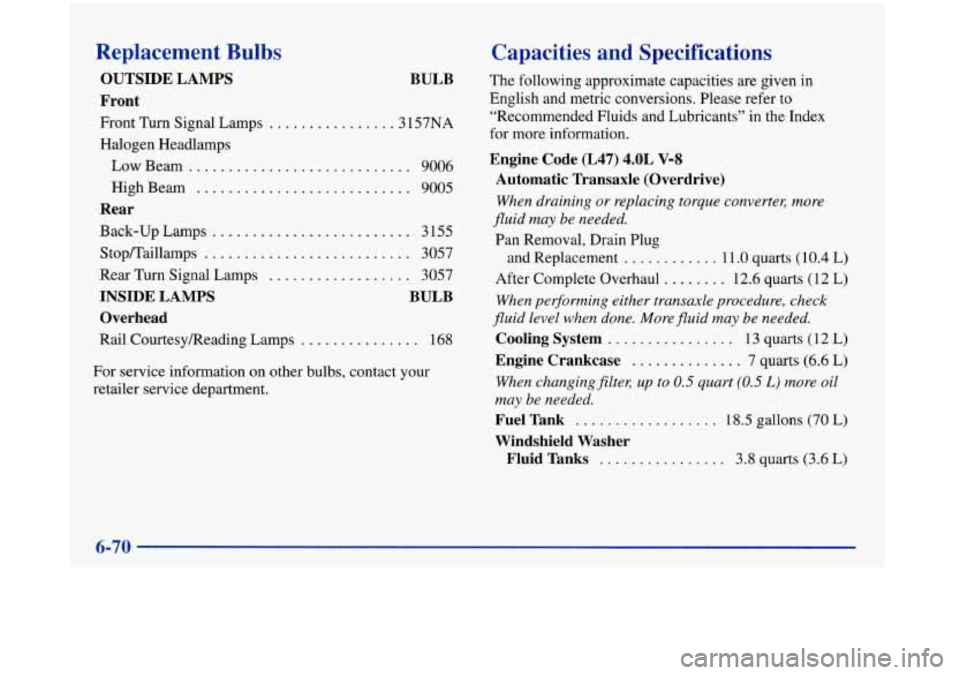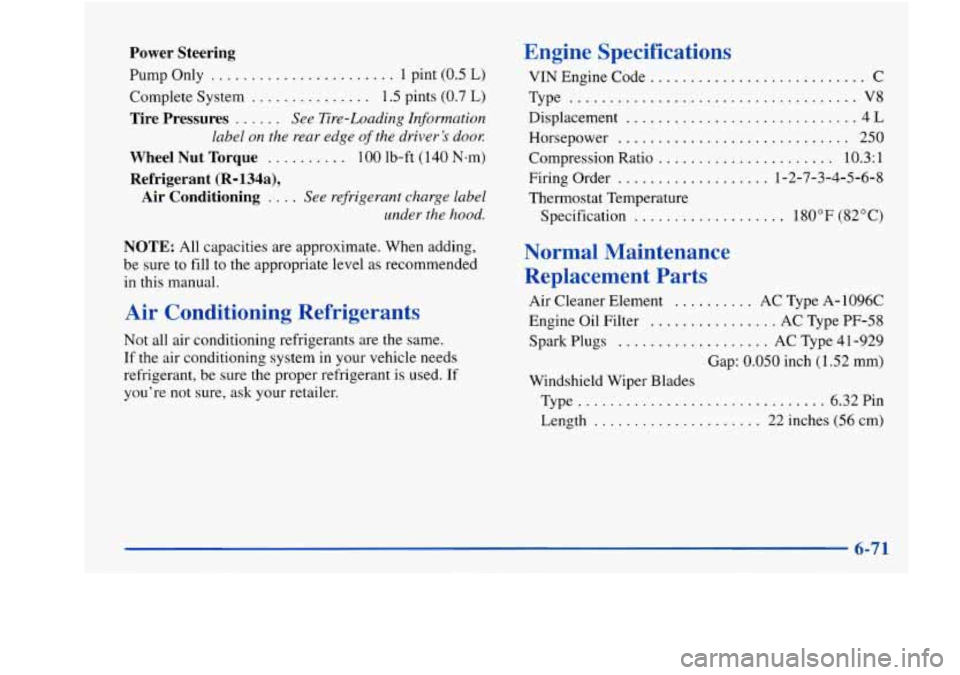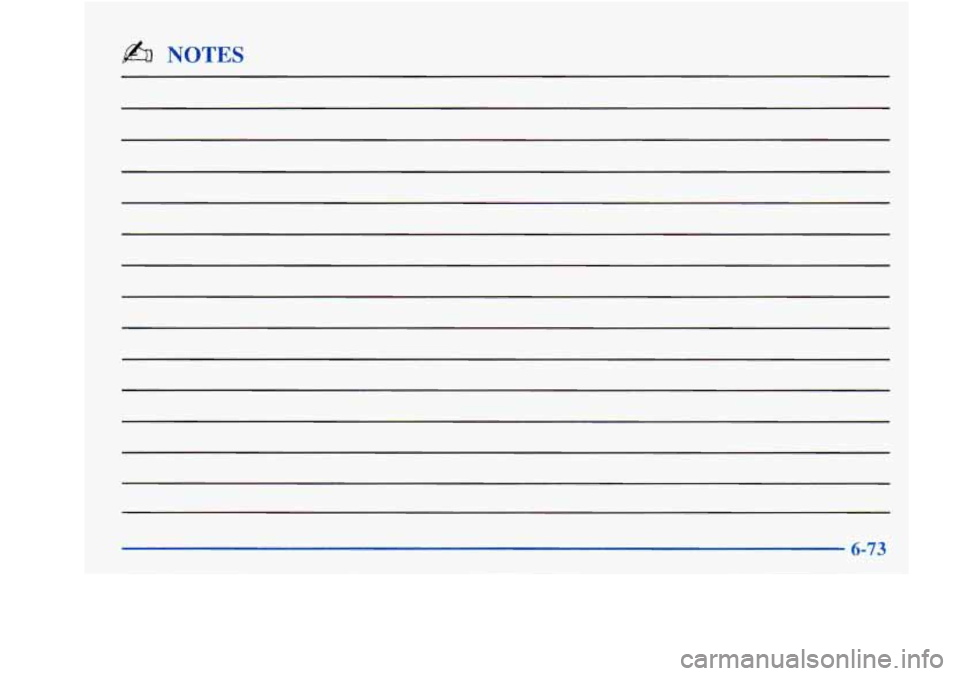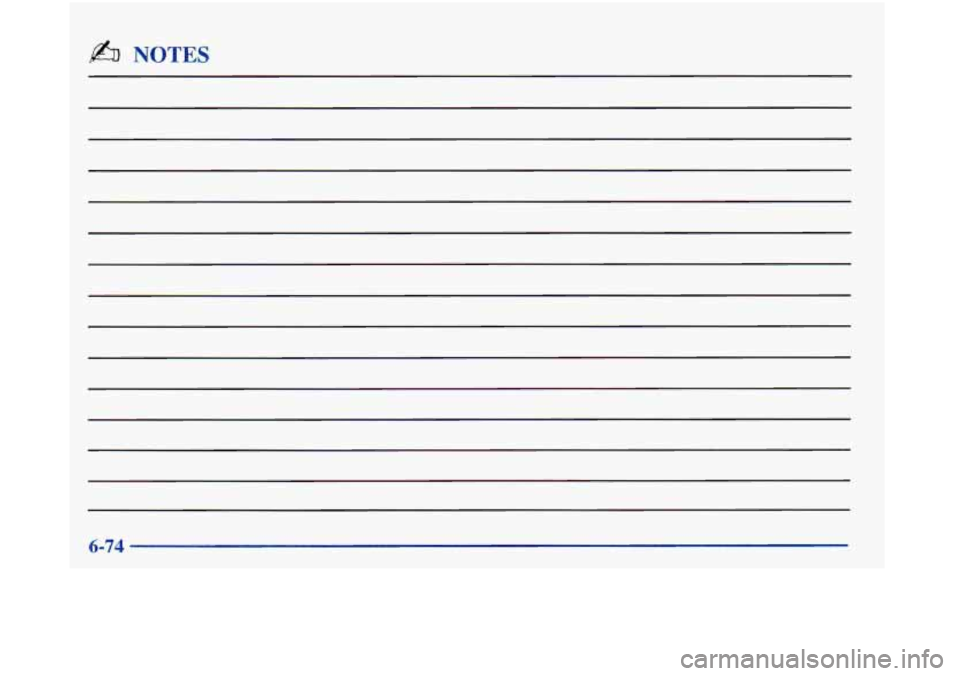Oldsmobile Aurora 1998 Owner's Manuals
Manufacturer: OLDSMOBILE, Model Year: 1998, Model line: Aurora, Model: Oldsmobile Aurora 1998Pages: 380, PDF Size: 19.75 MB
Page 321 of 380

Engine Compartment Fuse Block
ENGINE COMPARTMENT FUSE
BLOCK
I HORN I1 I I FOG LAMP 2 I I II II I
COOLING
FAN #2
COOLING
FAN #3
Fuse
1
2
3
4
5
6
7
8
9
10
11
12
13
14
Usage
Air Conditioning Center
Open
Open
Horn Open
Fog Lamp 2
Cooling Fan #2
Cooling Fan #3
Cooling Fan
ABS Main
ABS Pump Motor
Fog Lamp
Horn
Open
6-69
.~.
Page 322 of 380

Replacement Bulbs
BULB
OUTSIDE LAMPS
Front
Front
Turn Signal Lamps ............... .3 157NA
Halogen Headlamps
Low Beam
............................ 9006
High Beam
........................... 9005
Rear
Back-up Lamps ......................... 3 155
StopKaillamps
.......................... 3057
Rear
Turn Signal Lamps .................. 3057
INSIDE LAMPS BULB
Overhead
Rail CourtesyReading Lamps ............... 168
For service information on other
bulbs, contact your
retailer service department.
Capacities and Specifications
The following approximate capacities are given in
English and metric conversions. Please refer to
“Recommended Fluids and Lubricants” in the Index
for more information.
Engine Code (L47) 4.0L V-8
Automatic Transaxle (Overdrive)
When draining or replacing torque converteq more
fluid may be needed.
Pan Removal, Drain Plug
and Replacement
............ 11 .O quarts (10.4 L)
After Complete Overhaul
........ 12.6 quarts (12 L)
When per$orming either transaxle procedure, check
fluid level when done. More fluid may be needed.
Cooling System ................ 13 quarts (12 L)
Engine Crankcase .............. 7 quarts (6.6 L)
When changingfllteq up to 0.5 quart (0.5 L) more oil
may be needed.
Fuel Tank .................. 18.5 gallons (70 L)
Windshield Washer
Fluid Tanks
................ 3.8 quarts (3.6 L)
6-70
Page 323 of 380

Power Steering
Pump Only ....................... 1 pint (0.5 L)
Complete System ............... 1.5 pints (0.7 L)
Tire Pressures ...... See Tire-Loading Information
label on the rear edge
of the driver’s doox
Wheel Nut Torque .......... 100 lb-ft (140 Nam)
Refrigerant (R=134a),
Air Conditioning
.... See refrigeran.t charge label
under the hood.
NOTE: All capacities are approximate. When adding,
be sure to fill
to the appropriate level as recommended
in this manual.
Air Conditioning Refrigerants
Not all air conditioning refrigerants are the same.
If the air conditioning system
in your vehicle needs
refrigerant, be sure the proper refrigerant is used.
If
you’re not sure, ask your retailer.
Engine Specifications
VIN Engine Code ........................... C
Type
.................................... V8
Displacement ............................. 4 L
Horsepower ............................. 250
Compression Ratio
...................... 10.3: 1
Firing Order ................... 1-2-7-3-4-5-6-8
Thermostat Temperature
Specification
................... 180°F (82°C)
Normal Maintenance
Replacement Parts
Air Cleaner Element .......... AC Type A-1096C
Engine Oil Filter
................ AC Type PF-58
Gap:
0.050 inch (1.52 mm)
Spark Plugs
................... AC Type 4
1-929
Windshield Wiper Blades
Type
............................... 6.32Pin
Length
..................... 22 inches (56 cm)
Page 324 of 380

Vehicle Dimensions
Length .................. .205.4 inches (522 cm)
Width
.................... .74.4 inches (1 89 cm)
Height
.................... .55.4 inches (141 cm)
Wheelbase
.............. 1 13.8 inches (289.1 cm)
Front Tread
................ .62.5 inches (1 59 cm)
Rear Tread ................ .62.5 inches (159 cm)
Engine Accessory Belt Routing
The 4.0 L engine uses an engine accessory belt. This
diagram shows the features connected by the belt
routing. See “Maintenance Schedule” in the Index
for when to check the belt.
1. Tensioner Arm Pulley
2. Power Steering Pump Pulley
3. Idler Pulley
4. Alternator Pulley
5. Air Conditioner Compressor Pulley
6. Harmonic Balancer
Page 325 of 380

b NOTES
Page 326 of 380

@% NOTES
6-74
Page 327 of 380

@ Section 7 Maintenance Schedule
This section covers the maintenance required for your Aurora. Your vehicle needs these services to retain its safety,
dependability and emission control performance.
7-2
7-3
7-4
7-4
Introduction
How this Section is Organized
Part A: Scheduled Maintenance Services
Using Your Maintenance Schedule 7- 14 Part B: Owner Checks and Services
7- 18 Part C: Periodic Maintenance Inspections
7-20 Part
D: Recommended Fluids and Lubricants
7-22 Part
E: Maintenance Record
Page 328 of 380

IMPORTANT:
KEEP ENGINE OIL
AT THE PROPER
LEVEL AND CHANGE AS RECOMMENDED
n=
Have you purchased the GM Protection Plan? The Plan
supplements
your new vehicle warranties. See your
Warranty and Owner Assistance booklet, or your Aurora
retailer
for details.
Introduction
Your Vehicle and the Environment
Proper vehicle maintenance not only helps to keep your
vehicle in good working condition, but also helps the
environment. All recommended maintenance procedures are important. Improper vehicle maintenance can even
affect the quality of the air we breathe. Improper fluid
levels or the wrong tire inflation can increase the level
of emissions from your vehicle. To help protect our
environment, and to keep your vehicle in good
condition, please maintain your vehicle properly.
7-2
Page 329 of 380

How This Section is Organized
The remainder of this section is divided into five parts:
“Part A: Scheduled Maintenance Services” shows
what to have done and how often. Some of these
services can be complex,
so unless you are technically
qualified and have the necessary equipment, you should
let your retailer’s service department or another
qualified service center do these
jobs.
Performing maintenance work on a vehicle can
be dangerous. In trying to do some jobs, you can
be seriously injured.
Do your own maintenance
work only
if you have the required know-how
and the proper tools and equipment for the
job.
If you have any doubt, have a qualified
technician do the work.
If you are skilled enough to do some work on your
vehicle, you will probably want to get the service
information. See “Service and Owner Publications”
in the Index.
“Part B: Owner Checks and Services” tells you
what should be checked and when. It also explains
what you can easily do to help keep your vehicle in
good condition.
“Part C: Periodic Maintenance Inspections”
explains important inspections that your retailer’s
service department or another qualified service
center should perform.
“Part D: Recommended Fluids and Lubricants”
lists some recommended products to help keep your
vehicle properly maintained. These products, or their
equivalents, should be used whether you do the work
yourself or have it done.
“Part E: Maintenance Record” provides a place
for you to record the maintenance performed on your
vehicle. Whenever any maintenance is performed, be
sure to write it down in this part. This will help you
determine when your next maintenance should be done.
In addition, it is a good idea to keep your maintenance
receipts. They may be needed to qualify your vehicle
for warranty repairs.
Page 330 of 380

Part A: Scheduled
Maintenance Services
Using Your Maintenance Schedule
We at General Motors want to help you keep your
vehicle in good working condition. But we don’t know
exactly how you’ll drive it. You may drive very short
distances only a few times a week. Or you may drive
long distances all the time in very hot, dusty weather.
You may
use your vehicle in making deliveries. Or
you may drive it to work, to do errands or in many
other ways.
Because of all the different ways people use their
vehicles, maintenance needs vary.
You may even need
more frequent checks and replacements than you’ll find
in the schedules in this section.
So please read this
section and note how you drive.
If you have any
questions on how to keep your vehicle in good
condition, see your Aurora retailer.
This part tells you the maintenance services you should
have done and when you should schedule them.
If you
go to your retailer for your service needs, you’ll know
that GM-trained and supported service people will
perform
the work using genuine GM parts.
The proper fluids and lubricants to use are listed in
Part
D. Make sure whoever services your vehicle
uses these. All parts should be replaced and all
necessary repairs done before you or anyone else
drives the vehicle.
This schedule is for vehicles that:
0
0
0
carry passengers and cargo within recommended
limits. You will find these limits
on your vehicle’s
Tire-Loading Information label. See “Loading Your
Vehicle”
in the Index.
are driven on reasonable road surfaces within legal
driving limits.
use the recommended fuel. See “Fuel” in the Index.
7-4